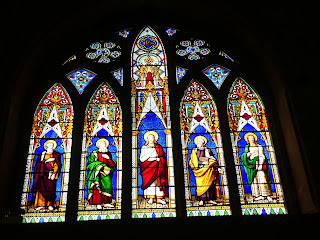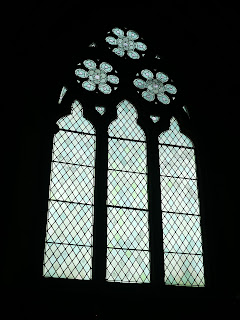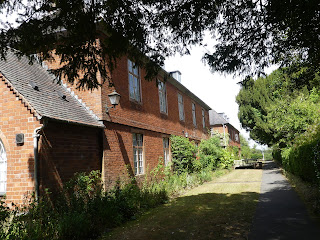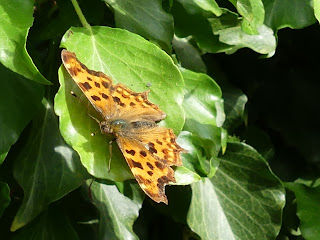It was D's birthday at the beginning of the month and in the afternoon he had suggested going to Temple Balsall and the farm shop in Balsall Common. I love Temple Balsall - we used to visit regularly but it is a place for some reason we haven't been to for a while. It is one of those places that is very atmospheric with a wonderful sense of place and history and yet at the same time it is timeless. I find it very peaceful there.
Temple Balsall takes its name from the preceptory of the Templars which was founded here c1150. When the order was disbanded in 1312 the Hospitallers gained the estate and kept it until the Dissolution in 1541.
Betony flowering in the car park and it was also in evidence in the churchyard of St Mary.
Rosebay Willowherb by the farmyard
There was a flower border with a mix of wild flowers and cultivated flowers.
The Master's House - Temple Balsall has some lovely old customs and traditions and the appointment of a master is one of them.
Two sisters who were the grand-daughters of Robert Dudley, Earl of Leicester, played an important role in the history of Temple Balsall. Lady Anne Holborne (d1663) left money for the church to be repaired and an endowment for a minister. Lady Katherine Leveson (d1674) endowed the hospital and the school. The restored church of St Mary the Virgin then served as a chapel for the parish and also for the hospital almswomen. The buildings are still in use for a similar purpose as the C17th foundation wished.
St Mary the Virgin
The Old Hall
We got chatting to a gentleman by the Old Hall and he confirmed the church was now open although it tended to close at 2.30 pm so I decided to have a quick look at the interior - it is years since I've been inside!
The Church underwent a restoration in 1848/9 by George Gilbert Scott. Pevsner says it has been called a "much maligned" restoration although he does add its texture is a bit too crisp but in detail it is entirely faithful. It was one of Scott's earlier restorations and shows he was a careful restorer. As I mentioned in my last post I am not overkeen myself on most Victorian restorations! Exterior wise his changes were limited to the gable tops of the buttresses where he added beasts and pinnacles above. He also added a polygonal bell tower.
The font is C17th restored in 1984.
I think there may have been a wedding in the church recently as there were flowers everywhere even at the end of each pew.
West window 1850 by O'Connor.
The Rose window above the West Window is just stunning - I have no idea when it was installed.
East Window by Powell dated 1907.
The sedilia and piscina pre-date the restoration.
I am not sure how old the tiles are I am guessing they are part of the Restoration?
Organ case from the restoration by Scott as is the stone pulpit.
The gentleman we spoke to said the new vicar was very keen on the environment and as you can see the church has won a bronze award for being an eco church which is great news.
So is this a church of the Templars or the Hospitallers? According to Pevsner historical evidence suggests it was built by the Hospitallers in 1320 or later but stylistically it is more likely to belong to the late C13th and the Templars. I personally would love to think it is a Knights Templar church.
A lovely churchyard angel
We wanted to revisit the walled garden which is at the end of the churchyard.
The walled garden is used for growing vegetables but there are also flower beds and fruit trees including medlar and quince.
We chatted to another gentleman who was working in the garden about growing vegetables.
The Hospital (now known as Lady Katherine Housing and Care) was founded in 1677 and was built originally by William Hurlbutt of Warwick. It was soon rebuilt on a grander scale by Francis Smith in the early C18th.
We stopped at the pool on the way back and found a lot of it had silted up presumably due to lack of rain but there were plenty of mallard around.
There is a lot more to see at Temple Balsall if we had had more time. You can continue along the Bread Walk to the Cemetery and there is also a patch of woodland. Crossing the lane there is Temple Fields Natural Burial Ground which is always a mass of wild flowers. A few hundred yards away is a nature reserve which I think at the moment is sadly closed as the hide needs maintenance.
Whenever I walk in this area I think of Edith Holden and "The Country Diary of an Edwardian Lady". She visited Temple Balsall and mentions it in her diary.
*D
*D
We stopped off briefly at the Farm Shop in Balsall Common on the way back and in the evening we all went for a meal at The Bear in Berkswell.
I also made D a Herefordshire Apple Cake which is one he particularly likes.
The garden at home has been full of butterflies and bees in recent days due to hot weather and the buddleias coming into flower.
Below a Comma and Green Veined White.
After last year is it so good to be seeing more bees and butterflies.
My sweet peas are finally starting to flower but I was late sowing them.
One of the sunflowers grown by D with a Marmalade Hoverfly.
Home made strawberry icecream made using homegrown strawberries. D made - I introduced him into the "delights" of my Magimix glacier icecream maker!
Rosebay Willowherb in the Garden
Comma in the garden
First homegrown jalapeno chilli pepper
Meadow Grasshopper I think - now safely in the garden but D found it in his bedroom!
The following day Packington Hall was opening for the National Garden Scheme and we went along as it is a place I have never visited. I'll write about the visit in the next blog post.
Reference: "The Buildings of England Warwickshire" by Chris Pickford and Nikolaus Pevsner, (Yale University Press 2016)
Photos taken by me with the Panasonic Lumix FZ330 bridge camera and those marked *D taken by my son with the Canon SX50HS bridge camera. (I don't particularly rate my photos but if anyone wishes to use one or mine or my son's I would be grateful for an email first - thanks).

























































































11 comments:
Super photos of a wide variety, I must look again when I have a bit more control over my touchpad! I love the bucolic look of the gates. I do hope the interior of the church provided a little respite from the heat for you. Do you have any information on the icon? It resembles some here at the cathedral at the restored shrine and I'm wondering if it's by the same artist, the late Sarah Crisp.
Thanks so much Debbie and thankfully it does seem a bit cooler inside a church. I am not sure about the icon. I will have to do some research and if I find out come back to you.
Just had another look - do you mean the one by the sedilia and piscina? If so I saw two very similar ones last week in Hereford Cathedral! I will check Pevsner for Herefordshire later there may be some info in there. As I said above if I find out anything will come back to you.
Lovely post. Temple Balsall always sounds and looks such an interesting place, the church looks perfect for a wedding. It sounds like D had a super birthday day both cake and ice cream look tasty. Hope you are staying cool this weekend:)
Thanks so much Rosie. Temple Balsall is one of my favourite places! Very hard to stay cool - sitting in front of a fan most of the time and finding it hard to sleep. Hope you are coping OK.
You were lucky that the church was open! I think it still looks fine after the restoration but I'm not very clued up about church interiors. I tend to like the more ornate catholic ones (even though I am not one). An overall interesting place to visit with the gardens and wild areas.
Your ice cream and cake look delicious! I have an ice cream maker but haven't used it for several years. I used to make lots of blackcurrant yoghurt ice cream when I had blackcurrants and the same recipe with raspberries. Both easy to make and delicious! I have never bothered with the custard base type ice cream.
Thanks so much Mandy. I think it was closed for a while during main covid outbreaks but good it is open again. I must admit I have never been in a Catholic church - son would like to go to one of the Pugin ones.
I stopped using my icecream maker years ago tbh. Such a faff - you have to have room in freezer to freeze bowl the night before and as for the custard making it takes ages to thicken. Not tried a yogurt icecream but sounds better. Son has now got the bug though! So it is good it may be used again. As you say it is delicious and beats bought ice cream any day!
Wonderful post and your photos are absolutely stunning. Thank you so much for sharing your journey. Warm greetings from Montreal ❤️ 😊 Canada 🇨🇦
Thanks so much Linda for your lovely comment and I send warm greetings in return.
Temple Balsall looks delightful as does the church. How lovely that met people that were able to help with further information.
Thank you - it is one of my "happy" places.
Post a Comment